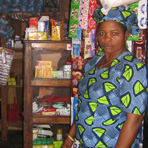The $10 Million Giveaway?
Move over Sally Struthers. Three young entrepreneurs found an easier way to raise millions for struggling businesses almost anywhere in the world. But don’t call it a handout -- it’s a loan. And, it’s funded by everyday people, like you, $25 at a time.
By KEVIN SITES, TUE AUG 21, 3:27 PM PDT
In their office in San Francisco's Mission District, Matt and Jessica Flannery and Premal Shah work with the fervor and techno savvy of an Internet startup aiming for an IPO. But they aren't chasing the cash for themselves.

Matt and Jessica Flannery and Premal Shah bring a youthful vibe to the world of microfinance.They're doing it for Esther Egbulu in Nigeria, a mother of six who wants an $800 loan to stock her shop with frozen chickens and turkey, or 31-year-old Choeun Sonin, who's requesting $1,000 to purchase a motorcycle taxi — just two of 15,000 entrepreneurs from 36 countries that their company, Kiva, has already helped.
Kiva, which means "unity" in Swahili, is a lending organization with a twist: Anyone with a bit of money and an Internet connection can step forward as a microlender to assist struggling third-world entrepreneurs get out of poverty.
After logging in, you can scroll through profiles of entrepreneurs, descriptions of their businesses, and the loan amounts they're requesting. Once you've decided who you want to lend to, you choose how much to lend, starting at as little as $25. (Individual lenders can fund an entire loan, but most of Kiva's loans are funded by multiple lenders.)
Funds are distributed to entrepreneurs through local non-profit microfinance partners in specific countries.

In Nigeria, Esther Egbulu wants an $800 loan to stock her shop with frozen chickens.The key is that the company is based on loans, not donations. "You're fundamentally connecting with someone else in a way that's based on mutual dignity, not this supplicant-benefactor relationship that you often see in philanthropy," says Premal.
There are some differences from traditional lending. Kiva loans require no collateral and they are zero interest. PayPal (Premal's former employer) processes the transactions without any fees.
Premal says the average loan request is about $650 and the average lender usually funds three different entrepreneurs at $25 each. Eighty percent of the lenders come from the U.S., 10% from Canada, and the remainder from the rest of the world.
Kiva says entrepreneurs pay back their loans an incredible 99% of the time — a default rate unheard of at traditional financial institutions. (The Kiva team expects the rate to increase to 5% as more borrowers complete the loan cycle.) And according to Premal, most lenders reinvest their money in other entrepreneurs after a loan is paid back.
Kiva's operational costs are covered by donations from lenders. The company does not take a commission from the loans facilitated on the site.

Matt and Jessica Flannery created Kiva after discovering different career goals in a pre-marriage counseling course.The way Kiva was founded is almost as interesting as what it's accomplishing. When Matt and Jessica attended a pre-marriage counseling session, they discovered their career goals could keep them apart. Jessica wanted to go to Africa to study microfinance; Matt was headed to Silicon Valley.
"We sort of just thought, ‘Well, we're supposed to be together. This will work itself out,'" Jessica recalls.
Things did work out, but in a way they hadn't first imagined. Shortly after they were married, Matt went to work for TiVo and Jessica went to Africa to work with a microfinance organization.
After visiting Jessica in Africa, Matt got the idea that perhaps what she was doing, microfinance, and what he was doing, high tech, could be combined — using the Internet to connect lenders and entrepreneurs.
They tested the concept on friends and family, spamming their wedding list and raising more than $3,000 for a handful of small businesses in Uganda.
Now Kiva has loans totaling $10 million.
Matt, Jessica and Premal credit their corresponding strengths for Kiva's success so far: Matt's technological know-how, Premal's salesmanship and Jessica's heart.

Kiva's president Premal Shah says corruption is a reality and he hopes transparency on Kiva's site will boost lenders confidence in microfinance.Kiva faces new challenges as its base of lenders and entrepreneurs expands.
Ensuring that money actually funds business is one problem. For instance, a borrower in Cambodia used a loan to fund a family wedding. But a Kiva volunteer monitoring loans in Cambodia discovered what happened then blogged about it — on Kiva's own website.
"We know that corruption exists," says Premal. "We are adamant about exposing it on our website." Transparency, he says, is the organization's goal.
In the grand scheme of things, $10 million in loans might seem like a small dent in world poverty, but Kiva's founders are thinking big.
"In year five we're looking at anywhere between $150 million to $280 million," says Premal — potentially enough to move the GDP of an entire nation at some point.
For now, it's enough to change the lives of 15,000 struggling entrepreneurs — and perhaps those making the loans, as well.

Matt and Jessica Flannery and Premal Shah bring a youthful vibe to the world of microfinance.
Kiva, which means "unity" in Swahili, is a lending organization with a twist: Anyone with a bit of money and an Internet connection can step forward as a microlender to assist struggling third-world entrepreneurs get out of poverty.
After logging in, you can scroll through profiles of entrepreneurs, descriptions of their businesses, and the loan amounts they're requesting. Once you've decided who you want to lend to, you choose how much to lend, starting at as little as $25. (Individual lenders can fund an entire loan, but most of Kiva's loans are funded by multiple lenders.)
Funds are distributed to entrepreneurs through local non-profit microfinance partners in specific countries.

In Nigeria, Esther Egbulu wants an $800 loan to stock her shop with frozen chickens.
There are some differences from traditional lending. Kiva loans require no collateral and they are zero interest. PayPal (Premal's former employer) processes the transactions without any fees.
Premal says the average loan request is about $650 and the average lender usually funds three different entrepreneurs at $25 each. Eighty percent of the lenders come from the U.S., 10% from Canada, and the remainder from the rest of the world.
Kiva says entrepreneurs pay back their loans an incredible 99% of the time — a default rate unheard of at traditional financial institutions. (The Kiva team expects the rate to increase to 5% as more borrowers complete the loan cycle.) And according to Premal, most lenders reinvest their money in other entrepreneurs after a loan is paid back.
Kiva's operational costs are covered by donations from lenders. The company does not take a commission from the loans facilitated on the site.

Matt and Jessica Flannery created Kiva after discovering different career goals in a pre-marriage counseling course.
"We sort of just thought, ‘Well, we're supposed to be together. This will work itself out,'" Jessica recalls.
Things did work out, but in a way they hadn't first imagined. Shortly after they were married, Matt went to work for TiVo and Jessica went to Africa to work with a microfinance organization.
After visiting Jessica in Africa, Matt got the idea that perhaps what she was doing, microfinance, and what he was doing, high tech, could be combined — using the Internet to connect lenders and entrepreneurs.
They tested the concept on friends and family, spamming their wedding list and raising more than $3,000 for a handful of small businesses in Uganda.
Now Kiva has loans totaling $10 million.
Matt, Jessica and Premal credit their corresponding strengths for Kiva's success so far: Matt's technological know-how, Premal's salesmanship and Jessica's heart.

Kiva's president Premal Shah says corruption is a reality and he hopes transparency on Kiva's site will boost lenders confidence in microfinance.
Ensuring that money actually funds business is one problem. For instance, a borrower in Cambodia used a loan to fund a family wedding. But a Kiva volunteer monitoring loans in Cambodia discovered what happened then blogged about it — on Kiva's own website.
"We know that corruption exists," says Premal. "We are adamant about exposing it on our website." Transparency, he says, is the organization's goal.
In the grand scheme of things, $10 million in loans might seem like a small dent in world poverty, but Kiva's founders are thinking big.
"In year five we're looking at anywhere between $150 million to $280 million," says Premal — potentially enough to move the GDP of an entire nation at some point.
For now, it's enough to change the lives of 15,000 struggling entrepreneurs — and perhaps those making the loans, as well.

